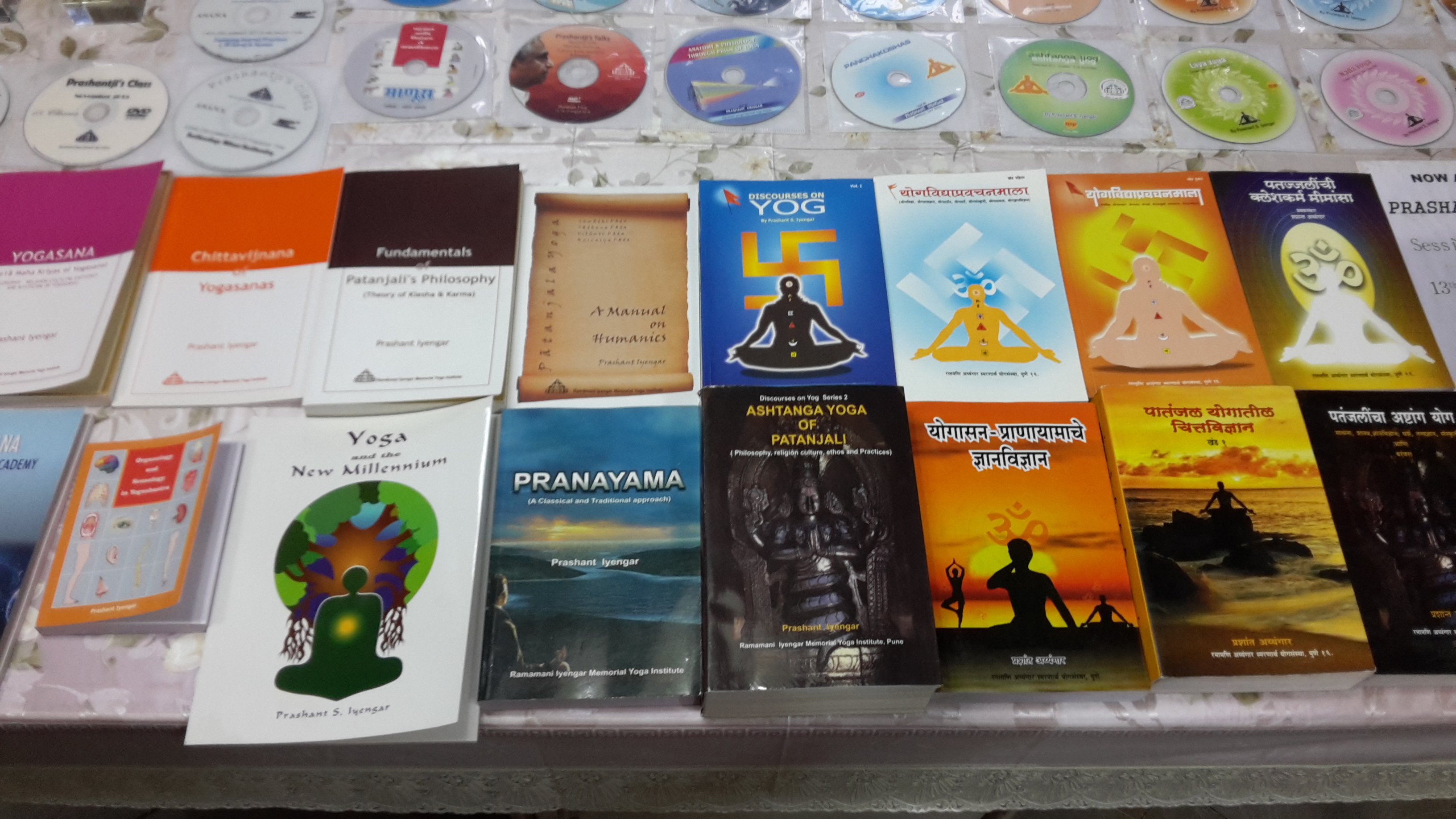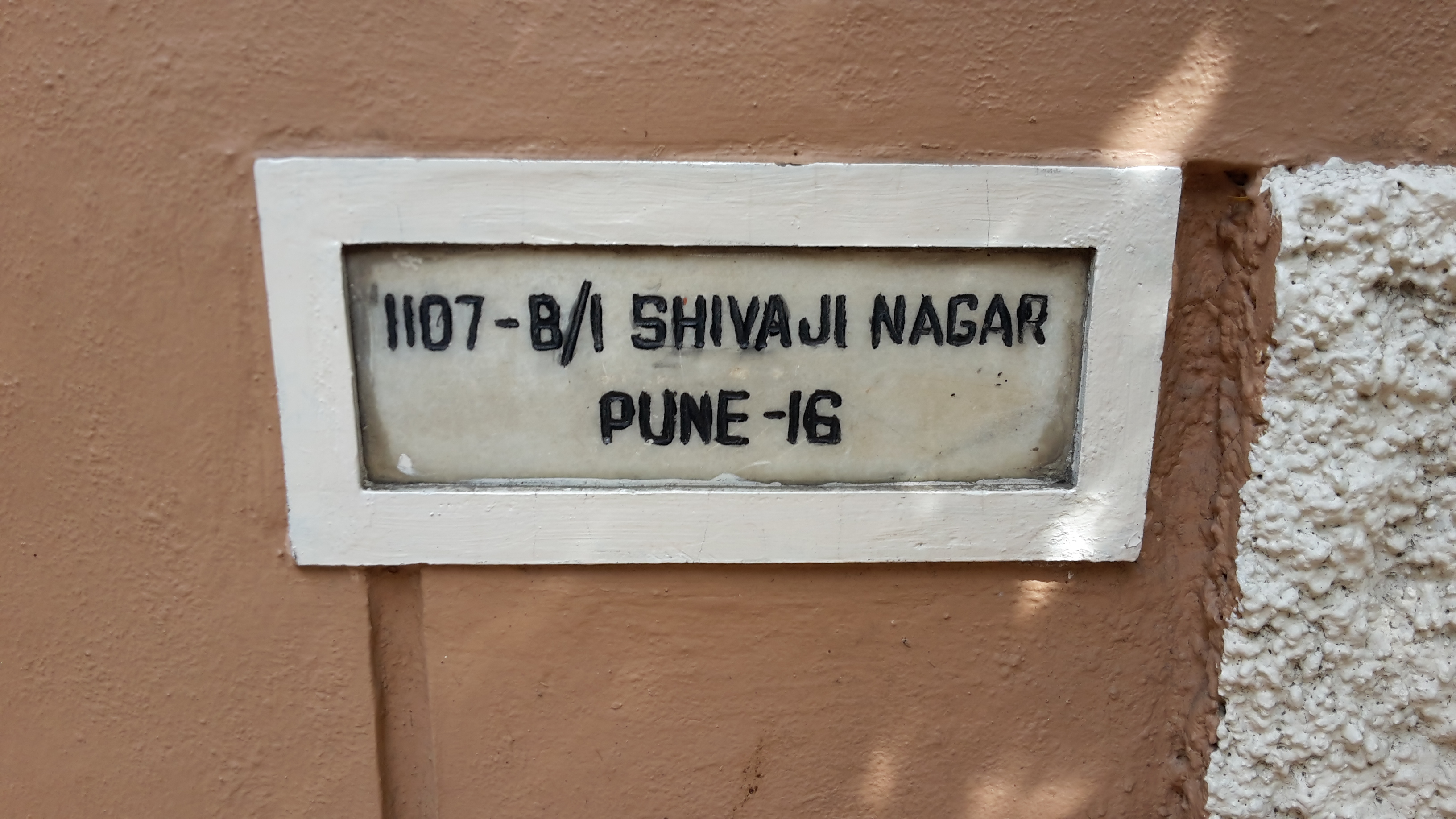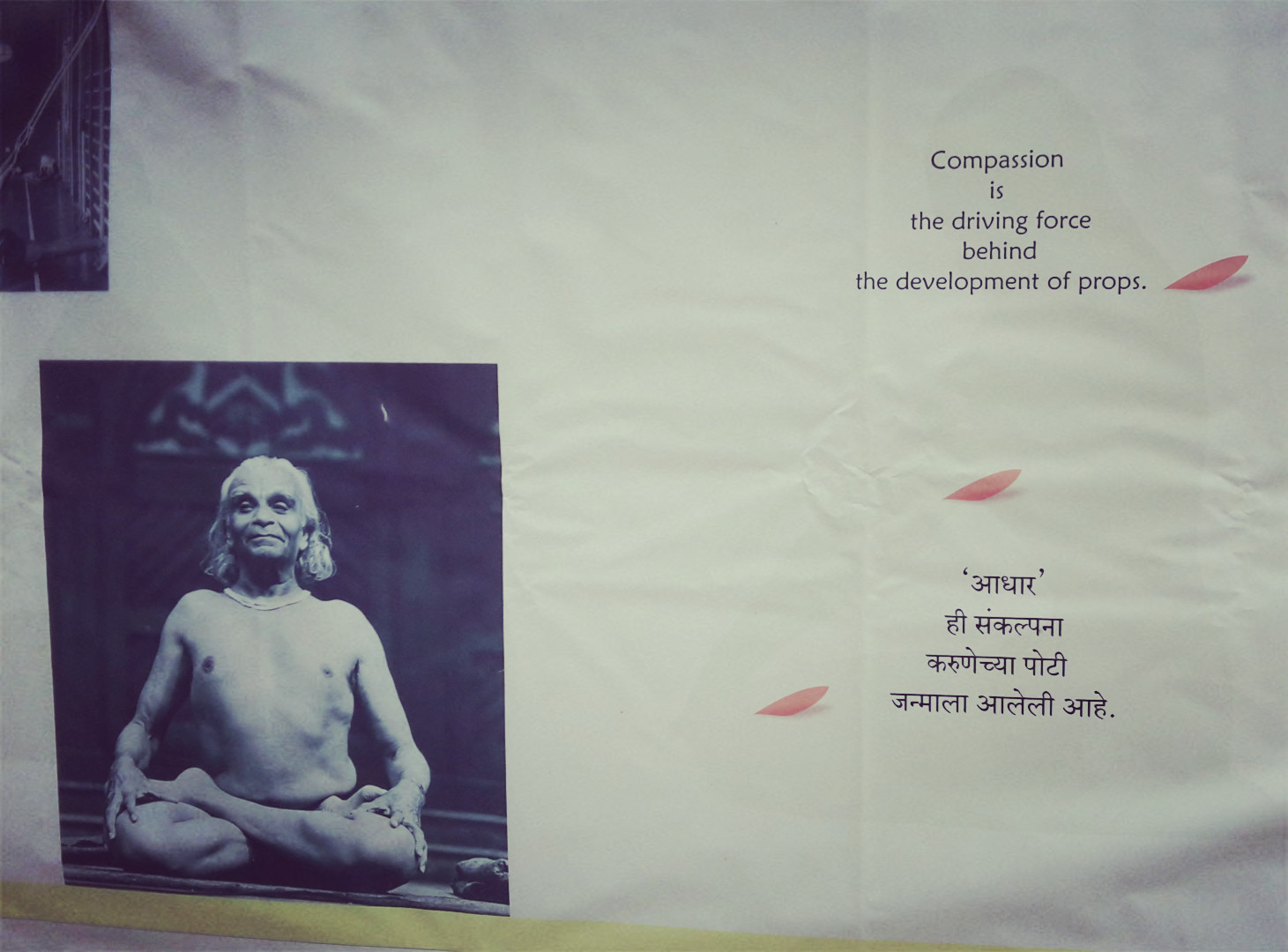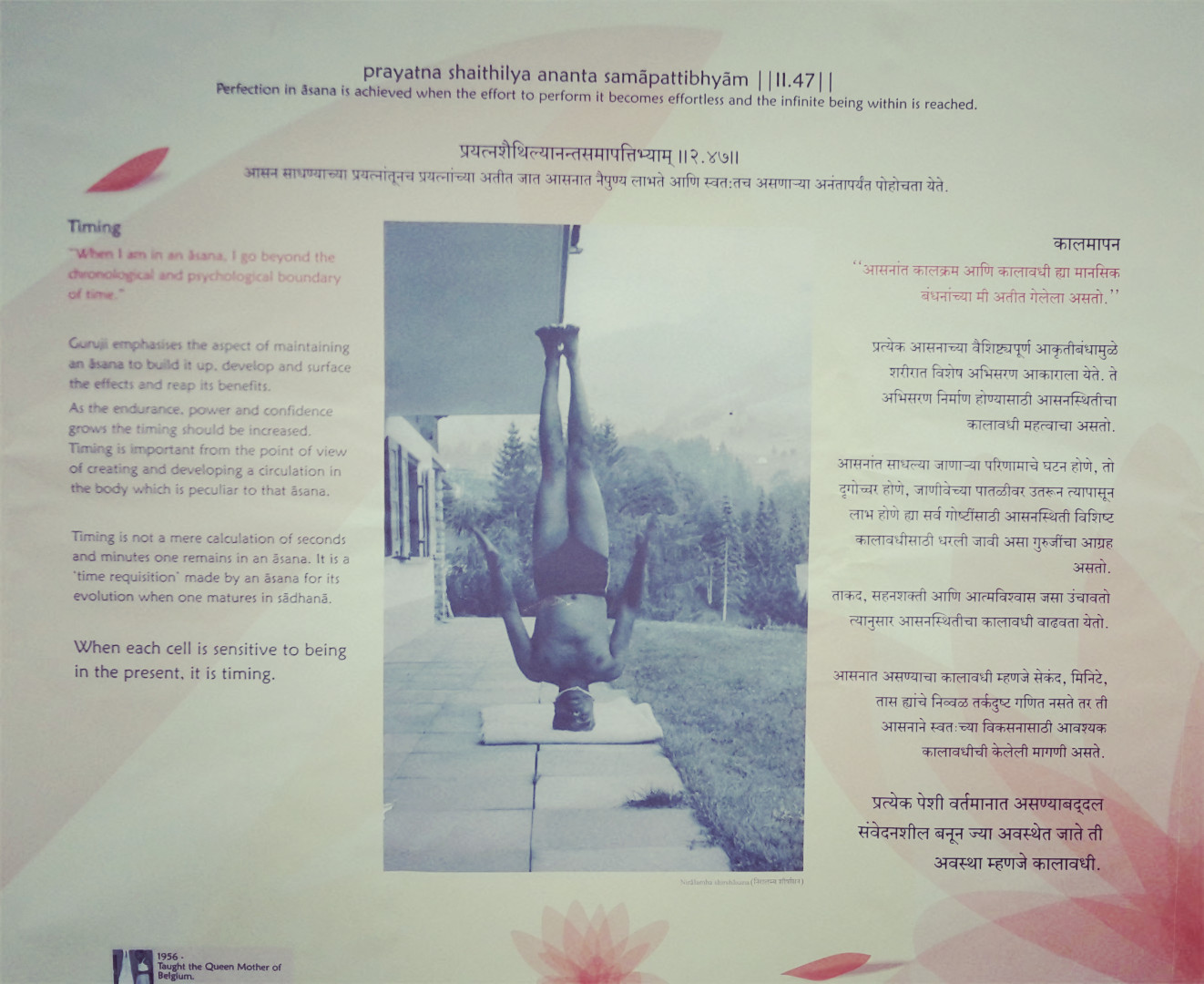
A few Iyengar Yoga publications
The other day I walked into the practice hall and saw Mr. Pandurang sitting on the stage and the Chinese students gathered around as the audience. I found out that the Chinese students had requested him to give them a talk about his experience with yoga and the institute over the years. Pandu’s talk was informative and interesting. Here’s what I remember from it.
Pandu came with BKS Iyengar to look at the site for the institute in the early 70s. By this time there were many Iyengar schools around the world and none in Pune. Guruji used to travel all around the world conducting workshops, but there was no institute in India where he could teach. The earliest students used to convene in Guruji’s house and practice in whatever space was available.
The decision to build the institute was also fraught with uncertainty. The fear that no one would come to practice at the institute was in everyone’s mind throughout the construction process. At one point Guruji told Pandu that if they were unable to use the building for yoga classes, then they could always rent it out as a wedding hall!
The weekend that the finishing touches were being made to the building, Guruji was in Bombay. His wife had been ill for a long time and she got worse during that weekend. She eventually ended up passing away and Pandu and everyone else at the institute weren’t sure of how to tell Guruji. Finally Pandu called Guruji and told him to head back to Pune as his wife was very ill. Guruji would later talk about how he had in inkling that there was something seriously wrong. By the time BKS Iyengar came back to Pune, his wife had already expired. They decided that they would name the institute after her.
The first students to come to the institute were from England. Some of the 70 odd  students brought along thick mats with them. Those thick mats (sort of like workout/gym mats) were a novelty here in India and localites were very curious about the mats. BKS Iyengar, being the innovative man he was, thought of different ways to use the mats. His creativity and love for his subject was such that he was constantly thinking of how to make the poses better and more accessible. That is how he came up with different ways to use ordinary objects such as chairs, blankets and blocks. According to Pandu there are 250 ways to use the Setubandhasana box. He also added that if he were conducting the teachers’ exam he would fail everyone because nowadays teachers aren’t as innovative as they used to once upon a time (referring to the fact that we don’t know the 250 different ways of using a prop).
students brought along thick mats with them. Those thick mats (sort of like workout/gym mats) were a novelty here in India and localites were very curious about the mats. BKS Iyengar, being the innovative man he was, thought of different ways to use the mats. His creativity and love for his subject was such that he was constantly thinking of how to make the poses better and more accessible. That is how he came up with different ways to use ordinary objects such as chairs, blankets and blocks. According to Pandu there are 250 ways to use the Setubandhasana box. He also added that if he were conducting the teachers’ exam he would fail everyone because nowadays teachers aren’t as innovative as they used to once upon a time (referring to the fact that we don’t know the 250 different ways of using a prop).
The story of the sticky mats is pretty much the same. This time it was a German student who brought the mat. In Europe they were using such mats under their carpets so that the carpets wouldn’t slip. The student thought out of the box and brought it back to India. Mr. Iyengar looked at the sticky mat and his little grey cells started working.

Mr. Iyengar’s many watches. Useful when you need to do 20 minute Sirsasanas.
On the subject of modern teachers he said Guruji always said that you should only follow one teacher. When he came across students who followed multiple teachers and schools he would say that you are not a lover, but a gatherer. You are just going around gathering the knowledge of yoga. There are many instances where people want to become yoga teachers without having practiced for any significant amount of time. Pandu emphasized the importance of a teacher being fundamentally sound. .Teachers with no personal practice and little experience may end up hurting students. This would give a bad name to a discipline which was already infamous. At the time Mr. Iyengar was teaching, yoga was looked upon with a bit of trepidation. The vast majority of people thought that it was circus tricks at best or black magic at worse. Changing people’s perceptions was an uphill task. And teachers at the time had to ensure that yoga as a practice shouldn’t be vilified.
On the nature of Guruji’s practice and teaching Pandu said Guruji was a hard task master. Students attending his class would be sore for a week afterwards. And as for his own practice, though he had a large family; he would never make any excuses. He practiced daily. Early morning he did pranayama. In the evening he would practice inversions. Pandu emphasized the importance of a daily practice. He said that those who don’t practice daily shouldn’t teach. He also mentioned that he’s noticed that when teachers start to gain popularity, the first thing out the window is their personal practice. All RIMYI teachers are regular with their own practice. Remember that once you lose a pose, it’s a struggle to get back to it. A Chinese girl in the audience asked how to balance teaching and learning if your livelihood depends on teaching yoga. Pandu thought for a moment and said that he would always recommend teach less and practice more. Give preference to your own practice. That’s what Guruji did.

The secret behind the ubiquitous tilak.
In the early 50s (between 1953-1954) Guruji was asked to teach at NDA (National Defence Academy). BKS Iyengar had to cycle for about 20 kms daily in order to get to class. Because of that he developed hernia. He treated hernia as his guru and allowed the condition to guide his practice in order to get rid of the condition. I was interested in knowing a bit more about the NDA days and found out that classes are going on their even now. When Guruji was no longer able to go he sent Pandu. Eventually Pandu also passed on the responsibility. Pandu remembers that the classes were for one and all, from the cadets to the officers. I do wonder if anyone posted in NDA during those days would have any pictures from that time.

Playing catch is exhausting.
The oldest running class at the institute is the women’s class (these days conducted by Gulnaz Dashti). Pandu was asked why was there a separate class for the women. In those days, was it to separate the sexes? Pandu replied that in Pune during those days women would be free only once the husband and the children had been packed off for the day and the housework was finished. This was typically between 9 am – 12 noon. So it was actually the women of Pune who requested that a special class be conducted for them, and that class continues to this day.
Your body is your guru. However, don’t do asanas when you ‘feel like it’. Sequencing is very important, else you will definitely experience problems. When Pandu and Prashant were practicing under Guruji, the practice was different every day. Tuesdays they would practice only forward bends. They would practice the Janu Sirsasana for 40-50 minutes at a time. Prashant and Pandu used to do all the forward bends in the sequence. Pandu also advised us not to do only the sirsasana and end the class. He said it’s important to do the Sarvangasana and Halasana. Also practice the Setubandha Sarvangasana. As far as be the body is concerned, there is a lot of bending in the circus. Ballet also has a lot of flexible bodies. But what happens in these disciplines is that the spine suffers.
Someone in the audience asked Pandu about the asana sequence that is described at the end of the books. Pandu said that the books were written many years ago and that many things have changed since then. Props have also changed. The ideas expressed in the books are a product of those times, and as time passed, the practice, ideas and philosophies evolved.
Pandu then told us a story about yoga. He said a long time ago when someone would fall sick they were told to take sanjeevani (a medicine). Then one day all the sanjeevani in the world finished and people went to God to ask for more. God told people that He couldn’t give them sanjeevani but he can give them yoga vidya. God told people that with yoga they will be able to maintain their health. However, the yoga vidya went to the rishi munis. And unfortunately, the rishi munis weren’t easily accessible to the common people. That’s when yoga teachers came into existence. They bridged the gap and brought the knowledge of yoga from the rishi munis to the common people. This is the tradition that Krishnamacharya and his disciples are a part of. For centuries they have de mystified an esoteric practice. They have brought it to the masses, but; emphasises Pandu; they have done it properly.

![POMELO_20160723084413_save[1]](https://yogawithpragya.com/wp-content/uploads/2016/07/pomelo_20160723084413_save1-1.jpg?w=169) Those following my Facebook updates would know that I attended my first Iyengar workshop last weekend. I had been looking forward to the workshop all month. Turns out, the workshop became special for me. It was conducted by 3 senior Iyengar teachers. It was held at Belur, BKS Iyengar’s birthplace. Iyengar teachers are legendary for being strict and no nonsense. So when, at the end of the first day I came up with the idea that maybe I could do my first ever interview for the blog with one of the most famous yoga teachers in the world, I didn’t think it would actually happen. But it did! And I was kicked. Below is the interview. At the end is the link to where you can hear it on YouTube.
Those following my Facebook updates would know that I attended my first Iyengar workshop last weekend. I had been looking forward to the workshop all month. Turns out, the workshop became special for me. It was conducted by 3 senior Iyengar teachers. It was held at Belur, BKS Iyengar’s birthplace. Iyengar teachers are legendary for being strict and no nonsense. So when, at the end of the first day I came up with the idea that maybe I could do my first ever interview for the blog with one of the most famous yoga teachers in the world, I didn’t think it would actually happen. But it did! And I was kicked. Below is the interview. At the end is the link to where you can hear it on YouTube.![POMELO_20160724194023_save[1]](https://yogawithpragya.com/wp-content/uploads/2016/07/pomelo_20160724194023_save1-1.jpg)
![POMELO_20160724062252_save[1]](https://yogawithpragya.com/wp-content/uploads/2016/07/pomelo_20160724062252_save1-1.jpg)


![POMELO_20160724193349_save[1]](https://yogawithpragya.com/wp-content/uploads/2016/07/pomelo_20160724193349_save1-1.jpg?w=576)